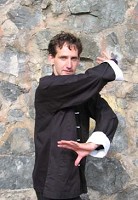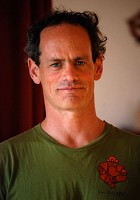 Shandor Remete, Shadow Yoga, Chaya Yoga
Shandor Remete, Shadow Yoga, Chaya Yoga : The Principles of Hatha Yoga
: The Principles of Hatha Yoga
 . North Atlantic Books, 2011.
. North Atlantic Books, 2011.

I'm taking a greater interest in yoga lately, especially since I started my, Daoist Circus Yoga for Kids, the funnest yoga class for kids ever. (Scroll to the bottom of the link.)
This book is small, elegant and I got a lot out of it. That surprised me because frankly, most books are just personal spin, and reiteration, especially books about movement and spirituality.
This quote in the introductions shows his commitment:
“I have also studied other disciplines: martial arts and the ancient Kathakali and Bharatanatyam dance forms of southern India. What has become apparent to me is that there is a common basis in the preparatory forms of all of these disciplines.”
Zander (as his students call him) often recommends his students study martial arts because they are too WEAK! And as irony would have it, quite a few talented and dedicated students of his have come to me to study or exchange ideas. I really should have read this book a few years ago, but better late than never.
On the primary goal of yoga he has this to say:
“Yoga is a spiritual system that deals practically with the process of enlightenment. The final goal is to differentiate the soul from everything that is not the soul. The method of yoga teaches the individual to discriminate, or to see the differences between these two things.”
I find that a bit troubling, mostly because he doesn't define soul and the word is so loaded with meaning in English. He doesn't even translate it back into Sanskrit as atman, although I think that is what he means. After thinking more deeply about the totality of the text, I started to think that when he says soul he means what we call in Chinese the three Hun, and this would be differentiated from the seven Pö. But more on that below.
He explains the the process is about skillfully reducing fixed patterns, and that if this end goal is kept in mind, the steps on the path will be self-revealing.
This was probably my favorite quote from the book:
“It is little understood that flexibility of the whole body can be achieved through the proper manipulation of the ankles, wrists, and neck. When these five regions are flexible the entire system softens and gains elasticity.”
By stating this he is suggesting that flexibility is always available and that mostly people practicing yoga are profoundly misunderstanding the subject. His biggest complaint is that people do not practice, nor do they comprehend the importance of, the preliminaries.
He has quite a bit of stuff about out-side the body perception and practice. This seems a bit rigid and formulaic to me, but else where he explains that the order and content of learning is not inherent and can be skipped by some people. Micro-macrocosm stuff like this planet is connected to your liver, can be read as jindan (golden elixir) instructions, but in the modern era I think we can skip right to talking about these visualizations as having a function in the perception action chain of motivations for movement. We agree on the importance of this kind of content but disagree on how to present it.
Zander describes a three body system which is like the Chinese one: the Causal Body karana sharira, the Subtle Body sukshama sharira, the Gross/Physical Body sthula sharira. I think this corrisponds to shen, qi and jing.
He describes kosha which are traps (or perhaps cavities?) which interweave the three bodies together, there are 7 of them according to a yoga text he references. These are what hold the 7 shadow bodies together.
Zander explains the very complex relationship between breathing and posture, but then says that all of this is preliminary to breathing without any fixed pattern.
There is a chapter on Nauli kriya which was outside my knowledge base. On further consideration I noticed it looks a lot like the chair pose in Paulie Zink's daoyin, and a lot like one of the basic movements of Tibetan trulkhor. I hadn't considered this type of yoga before but it might prove very useful for people differentiating the dantian from the kua.
The title of the book comes from this quote:
"The appearance of the body is nothing but frozen shadows.” -- Allama Prabhudeva.
“The shadows are seven in number: the shadow of joy, the shadow of the intellect, the shadow of the mundane mind, the power of principle, the gross structure, the luster of the skin, and the shadow on the ground. Each shadow is a blockage of light.”
Elsewhere he describes them differently, so I don’t think he intended this list to pin it down. They are all obstacles, but they are the obstacles we happen to have to work with. I could plumb these further: luster of the skin is probably radiance, shadow on the ground is probably pure earth power, the power of principle is probably bio-mechanics and jin or ground-path power, intellect is probably having preferences, the shadow of joy has me a bit stumped but I'm guessing it is unconsciously obscuring our animal nature with nice-ness.
I thought of hun and pö as a translation of soul and shadow bodies into Chinese. In Chinese cosmology, the hun and pö exist as a form of polarity holding us together during our life, and they disperse at death. The hun are said to disperse within the first three days (they go up!), but even in a normal death the pö can take up to seven years to disperse (they go down!). This is why proper funerals are so important in Chinese culture, there is a danger of creating a ghost if the pö don't fully disperse. In a sense we can think of the pö as unresolved conflicting emotions and weak or desperate desires. If a grandparent dies really wanting a cigarette, there is a chance they can pass on that conflicted emotion to a child as some quirky behavior. That is a psychological "ghost" but there are other types. A desire for power or revenge would tend to be more demonic than ghostly, but essentially made of the same ephemeral stuff.
An immoral, or xian, in Daoist cosmology is a person who has a complete death at the moment of death. That is, their hun and pö completely disperse instantly because they have already completely differentiated them (like Zander is suggesting is the goal of yoga: to differentiate the souls from the shadow bodies). Thus great immortals like Zhang Daoling rose up in broad daylight with their dogs and chickens at the moment of death.
Zander offers a translation of the term samadhi as “absorption." I think that is exactly the way to translate it if we are talking about a movement tradition like daoyin, theater, or martial arts.
Anyway it is a small elegant book and I recommend it!









 September being Yoga Month, I happened on an article yesterday in Common Ground called, "Should You Sleep With Your Yoga Teacher." It's hardly worth linking too...and sorry it's not on-line yet. In a few words; it was wishy-washy. The majority of Yoga teachers quoted the precept, "Do no harm." Which is of course a fantasy, not a precept. But it makes an interesting contrast with the Martial Arts precept, "Do maximum harm."
September being Yoga Month, I happened on an article yesterday in Common Ground called, "Should You Sleep With Your Yoga Teacher." It's hardly worth linking too...and sorry it's not on-line yet. In a few words; it was wishy-washy. The majority of Yoga teachers quoted the precept, "Do no harm." Which is of course a fantasy, not a precept. But it makes an interesting contrast with the Martial Arts precept, "Do maximum harm."